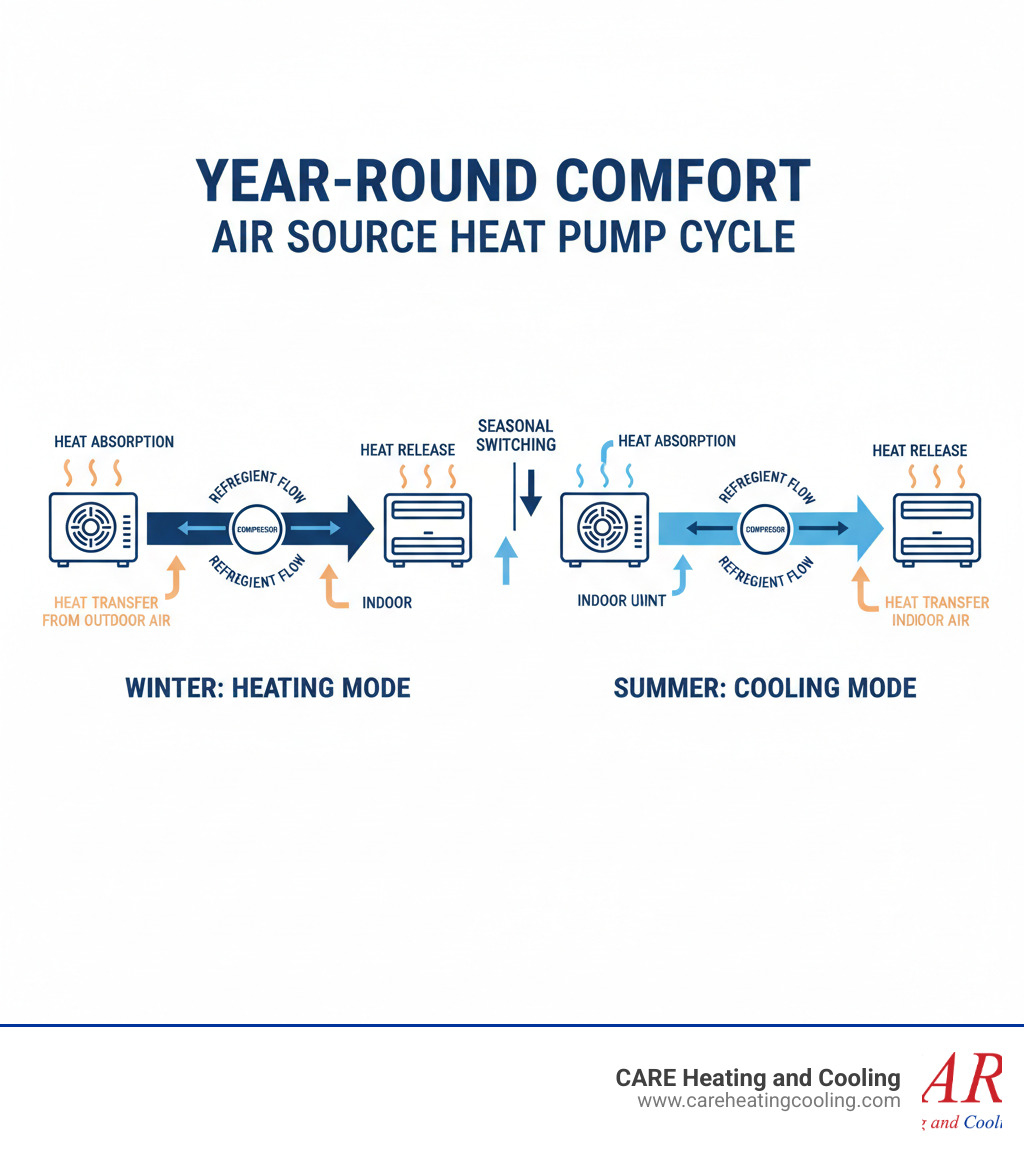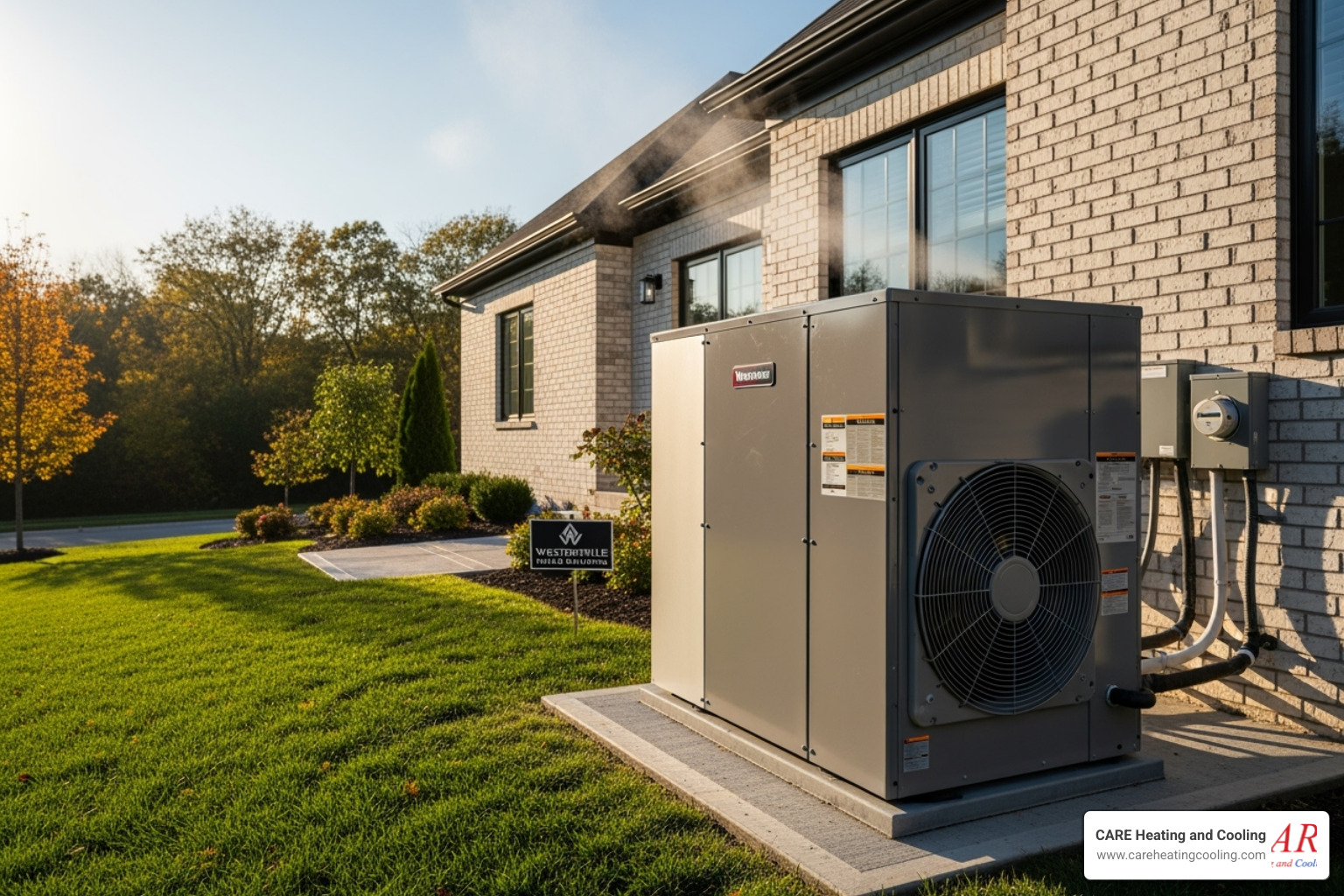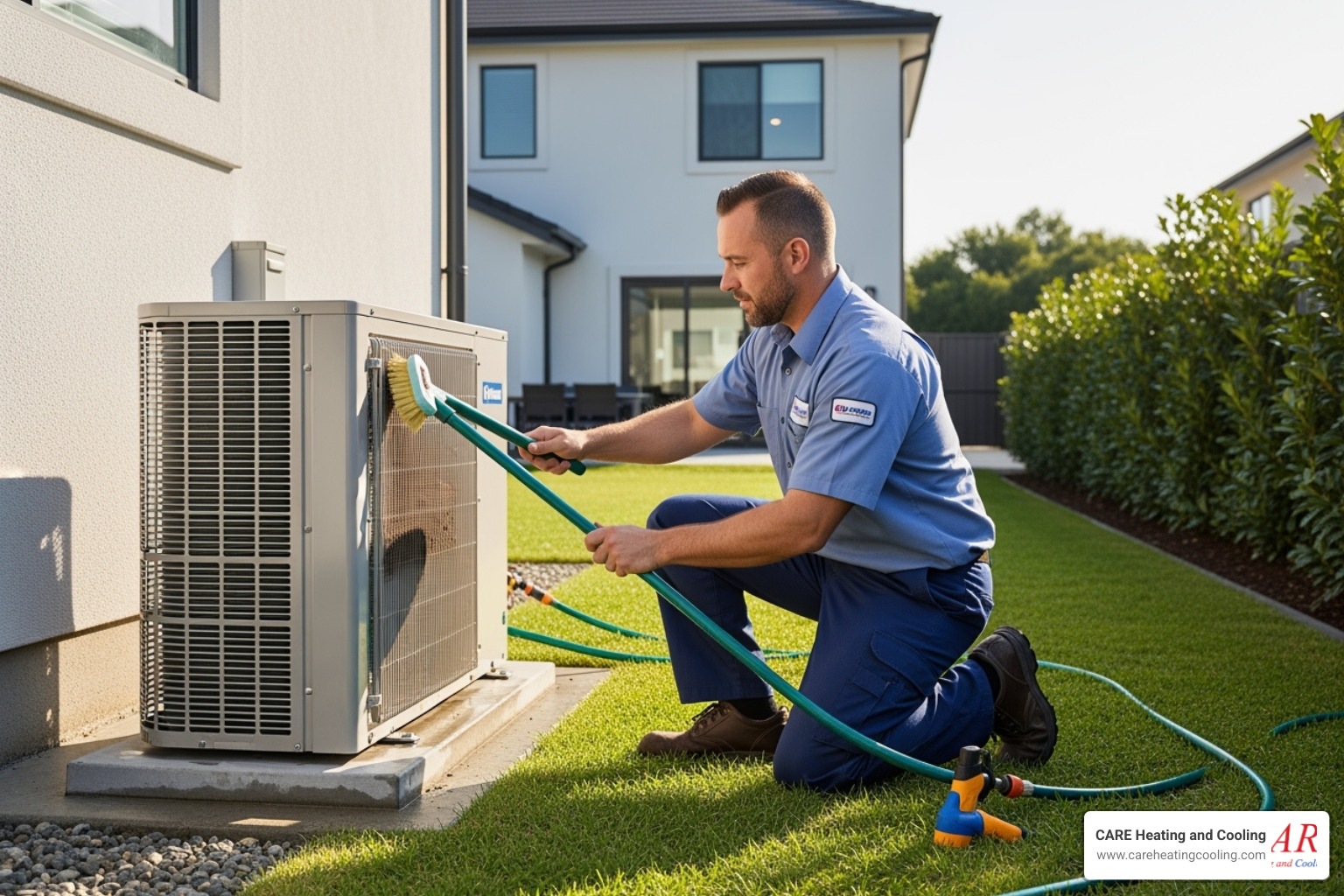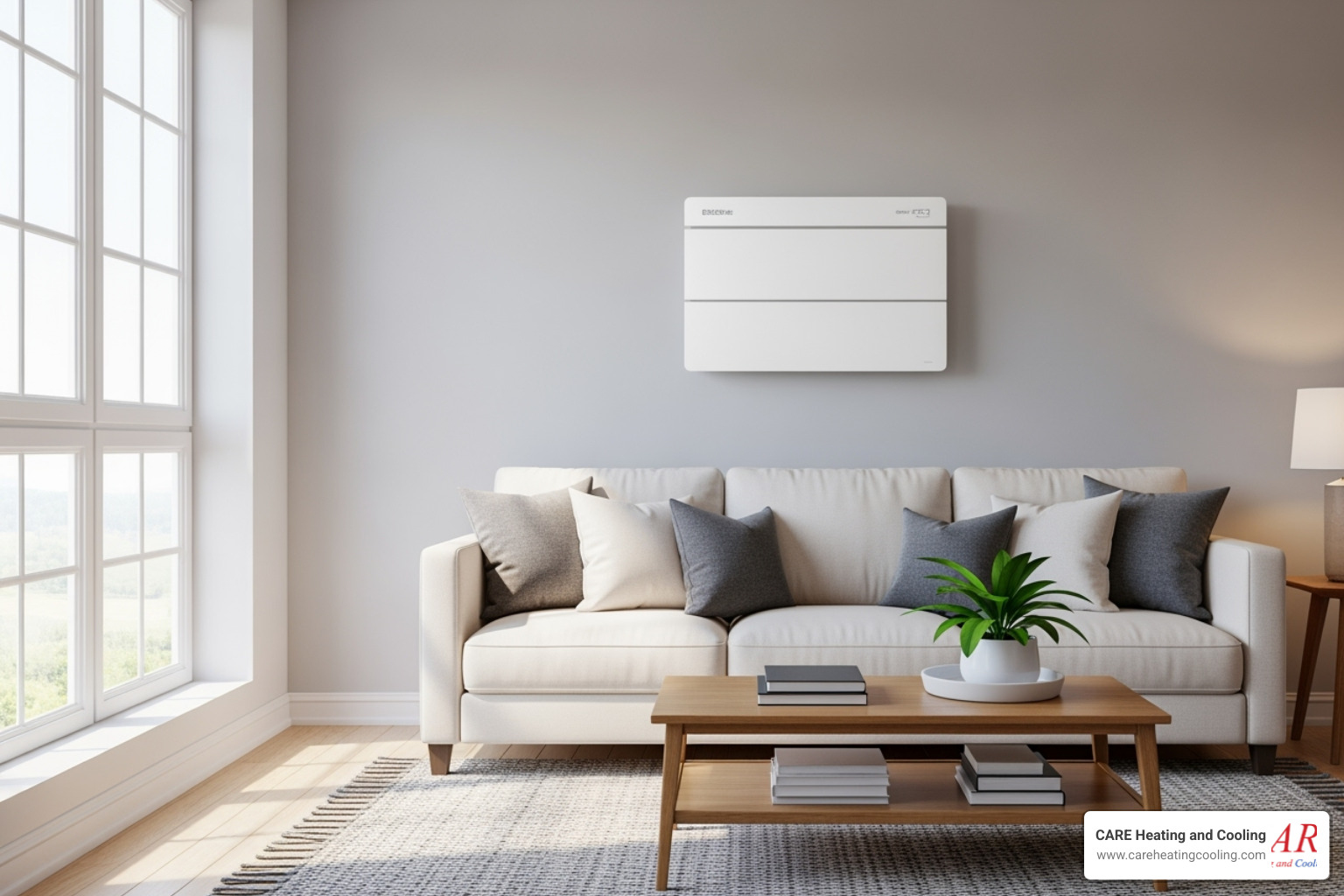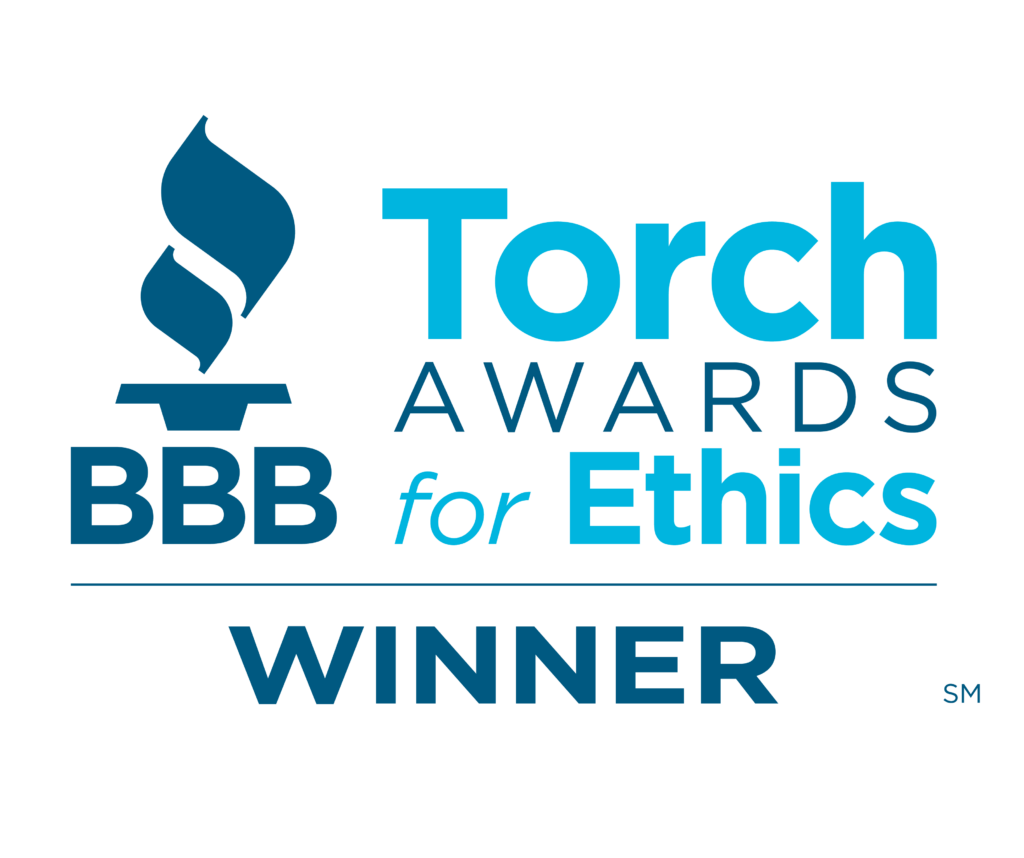Why Air Source Heat Pumps Are Perfect for Westerville Homes
Air source heat pump Westerville homeowners are finding a single system that handles both heating and cooling with impressive efficiency. These innovative units transfer heat rather than create it, making them up to 50% more efficient than traditional electric heating systems.
Quick Facts About Air Source Heat Pumps in Westerville:
- Year-round comfort: One system provides both heating and cooling
- Energy savings: Reduce electricity use by approximately 50% compared to electric resistance heating
- Climate suitable: Work effectively in Ohio’s moderate climate, even in temperatures down to 32°F
- Dual function: Cool your home in summer, warm it in winter using the same equipment
- Improved air quality: Better dehumidification than standard air conditioners
- Quiet operation: Designed to run quieter than traditional HVAC systems
Heat pumps work by moving existing heat from one place to another. In winter, they extract heat from outdoor air and bring it inside. In summer, they reverse this process, removing heat from your home and releasing it outdoors.
This technology makes perfect sense for Westerville’s climate. Our area experiences hot summers and moderately cold winters – ideal conditions for air source heat pumps to operate efficiently year-round.
Unlike furnaces that burn fuel to create heat, or air conditioners that only cool, heat pumps use electricity to transfer heat. This process requires much less energy, which translates to lower utility bills and reduced carbon emissions.
The key advantage is versatility. Instead of maintaining separate heating and cooling systems, one heat pump handles both jobs. This means fewer components to maintain, less equipment taking up space, and simplified home comfort management.
How Air Source Heat Pumps Provide Year-Round Comfort
Here’s what makes an air source heat pump Westerville system so brilliant: it doesn’t create heat or cold – it simply moves heat from one place to another. Think of it as nature’s recycling program for comfort! This heat transfer principle is the same technology that keeps your refrigerator cold, but with a clever twist that lets it work in reverse.
The secret ingredient that makes year-round comfort possible is something called a reversing valve. This nifty component changes the direction your refrigerant flows through the system, allowing your heat pump to flip between heating and cooling modes as easily as flipping a light switch. It’s perfectly designed for Ohio’s changing seasons – warming your home during those chilly Westerville winters and keeping you cool when summer humidity rolls in.
Want to dive deeper into the mechanics? Check out our detailed guide on How Heat Pumps Work to see exactly what’s happening inside your system.
The Heating Cycle: Drawing Warmth from Cold Air
Here’s where heat pumps get really impressive. Even when it feels freezing outside, there’s still heat energy in the air – your air source heat pump is smart enough to find it and use it. The outdoor unit absorbs this ambient heat into a special refrigerant, even when temperatures drop to 32°F or below.
Next comes the refrigerant compression phase. Your heat pump’s compressor squeezes this refrigerant, which dramatically increases both its temperature and pressure. Think of it like pumping up a bicycle tire – the pump gets warm from the compression process.
The now-hot refrigerant travels indoors where it disperses warmth through your home’s air distribution system. A fan pushes this heated air through your ductwork, delivering cozy comfort to every room.
For those particularly brutal Westerville winter days when temperatures plummet well below freezing, most heat pumps team up with supplemental heat sources. This backup system – usually electric resistance coils – kicks in to ensure your home stays perfectly warm even when Mother Nature throws her worst at us.
The Cooling Cycle: A High-Efficiency Air Conditioner
When summer arrives and you need cooling relief, your heat pump simply reverses its operation. That reversing valve we mentioned earlier switches direction, and suddenly your system becomes a highly efficient air conditioner.
During cooling mode, your heat pump removes indoor heat by having warm, humid air from inside your home pass over the indoor coil. The refrigerant absorbs this unwanted heat and humidity, then carries it outside where it releases heat outdoors into the ambient air.
The cooler, dehumidified air circulates back through your home, creating that refreshing comfort you crave on hot Ohio days. This dehumidification benefit is often better than what you’d get from a standard air conditioner, helping your home feel comfortable even at higher temperatures.
If you ever notice your cooling isn’t quite right, our team is ready to help with professional Air Conditioning Repair services to get you back to optimal comfort.
Top Benefits of Installing a Heat Pump in Your Westerville Home
When you’re considering upgrading your home’s comfort system, an air source heat pump Westerville installation offers remarkable advantages that traditional heating and cooling systems simply can’t match. These modern marvels are engineered to work smarter, not harder, delivering comfort while keeping your wallet happy.
The standout benefit is energy efficiency. Heat pumps can slash your electricity use for heating by approximately 50% compared to electric resistance heating. That’s real money staying in your pocket every month! Instead of burning fuel or using energy-hungry electric coils to create heat, these systems simply move existing heat from one place to another – a much more efficient process.
Having single-system convenience means no more juggling separate heating and cooling units. One heat pump handles both jobs beautifully, simplifying your home’s HVAC setup and reducing the number of systems you need to maintain. It’s like having a Swiss Army knife for home comfort.
Eco-friendly operation is another compelling reason Westerville homeowners are making the switch. Since heat pumps run on electricity rather than burning fossil fuels directly, they produce fewer carbon emissions. You’re not just saving money – you’re helping protect the environment too.
Modern heat pumps also deliver improved indoor air quality through continuous air circulation and filtration. As they work, they’re constantly moving air through filters, removing dust, pollen, and other particles. Plus, their quiet performance means you’ll enjoy comfort without the rattling, banging, or whooshing sounds that older systems often make.
Heat Pumps vs. Traditional HVAC Systems
When you compare an air source heat pump Westerville system to traditional furnaces and air conditioners, the differences really highlight why heat pumps are becoming so popular with smart homeowners.
| Feature | Heat Pump | Furnace (Traditional Heating) | Air Conditioner (Traditional Cooling) |
|---|---|---|---|
| Function | Both heating and cooling | Heating only | Cooling only |
| Efficiency | Highly efficient (transfers heat) | Less efficient (generates heat by burning fuel) | Efficient (transfers heat) |
| Fuel Source | Electricity | Natural gas, propane, oil | Electricity |
| Environmental Impact | Lower carbon emissions (uses electricity) | Higher carbon emissions (burns fossil fuels) | Uses electricity |
| Year-Round Comfort | Yes, one system for all seasons | No, needs separate AC for cooling | No, needs separate furnace for heating |
| Lifespan | 15-20 years (with maintenance) | 15-20 years (with maintenance) | 10-15 years (with maintenance) |
The beauty of a heat pump is its versatility – it’s like getting two appliances in one reliable package. Traditional systems require you to maintain separate heating and cooling equipment, which means double the potential for breakdowns and repairs. If your current furnace is giving you trouble, our Furnace Repair team can help, but it might be the perfect time to consider the long-term benefits of upgrading to a heat pump system.
Improved Dehumidification and Air Filtration
Here’s something many Westerville homeowners don’t realize: high-efficiency heat pumps are fantastic at tackling our area’s sticky summer humidity. They actually dehumidify better than standard central air conditioners, which means you’ll use less energy while enjoying better comfort during those muggy Ohio summers.
This superior moisture control means you can often set your thermostat a few degrees higher and still feel perfectly comfortable. Your home won’t have that clammy feeling that makes you want to crank the AC down to arctic levels.
The continuous air circulation that’s built into heat pump operation provides another bonus – ongoing air filtration. While it’s not the same as having a dedicated air purification system, the constant movement of air through filters helps capture dust, allergens, and other particles that would otherwise float around your living spaces.
This is especially great news for family members who deal with allergies or respiratory sensitivities. You’re not just getting heating and cooling – you’re getting cleaner, healthier air throughout your home, all year long.
Your Guide to Air Source Heat Pump Westerville Maintenance and Repair
Think of your air source heat pump Westerville unit like a reliable friend – treat it well, and it’ll take care of you for years to come. The secret to getting the most out of your investment lies in proactive care that keeps your system running smoothly and prevents those dreaded middle-of-winter breakdowns.
Regular maintenance isn’t just about avoiding problems (though that’s certainly a big part of it). It’s about ensuring your heat pump operates at peak efficiency, keeping your energy bills reasonable and your home comfortable year-round. When you stay on top of basic care, you’re also extending your system’s lifespan and maintaining your warranty coverage. Our experienced technicians are always ready to help with comprehensive HVAC Services Provided by Technicians when you need professional support.
Maximizing Your Heat Pump’s Lifespan
With proper care, your air source heat pump can serve your Westerville home faithfully for 15-20 years – that’s a pretty impressive run for any home appliance! The key is combining simple DIY maintenance tasks with regular professional tune-ups.
There are several things you can do yourself to keep your heat pump happy. Monthly filter changes are probably the most important – a dirty filter is like trying to breathe through a straw, making your system work much harder than necessary. During peak seasons, you might need to check filters even more frequently.
Keeping your outdoor unit clear is equally crucial. That outdoor unit needs room to breathe, so maintain at least two feet of clearance all around it. Clear away leaves, grass clippings, snow, and any other debris that might block airflow. Your heat pump will thank you with better performance and lower energy bills.
Gentle coil cleaning helps maintain efficient heat transfer. The outdoor coil can collect dirt and grime over time, which acts like a blanket preventing proper heat exchange. A gentle rinse with your garden hose (when the unit is off) can work wonders.
During winter months, checking for excessive ice buildup is important. While some frost during defrost cycles is perfectly normal, thick ice coating the unit signals a problem that needs professional attention.
Professional maintenance visits are where the real magic happens. We recommend scheduling tune-ups twice yearly – once before heating season and once before cooling season. During these visits, our technicians inspect all components, check refrigerant levels, clean internal parts, lubricate moving components, and catch small issues before they become expensive problems. For seasonal-specific guidance, check out our Heat Pump Maintenance Tips for Summer.
Common Signs You Need Heat Pump Repair Westerville
Even well-maintained heat pumps can develop issues, and recognizing the warning signs early can save you from bigger headaches down the road. Your air source heat pump Westerville unit will usually give you plenty of hints when something’s not quite right.
Strange noises are often the first red flag. Heat pumps should run relatively quietly, so grinding, squealing, rattling, or bubbling sounds definitely warrant attention. These noises often indicate worn components, loose parts, or refrigerant issues that need professional diagnosis.
Declining performance is another telltale sign. If your home isn’t reaching the temperatures you’ve set, or if you notice hot and cold spots throughout the house, your heat pump might be struggling with airflow issues, refrigerant problems, or component failures.
Unexpectedly high energy bills can signal efficiency problems. When heat pumps start losing their efficiency, they have to work much harder to maintain comfortable temperatures, which shows up quickly on your utility bills. If your bills spike without a corresponding change in usage, it’s time for a professional evaluation.
Frequent cycling – when your heat pump turns on and off repeatedly in short bursts – indicates problems with sizing, airflow, or electrical components. This short-cycling puts unnecessary wear on your system and wastes energy.
Excessive ice formation on the outdoor unit, especially during milder weather, suggests serious issues with refrigerant levels or airflow. While light frost during defrost cycles is normal, thick ice coating the coils is not.
When you notice any of these warning signs, don’t wait – early intervention almost always means simpler, less expensive repairs. Our team has extensive experience with all types of heat pump issues, and we’ve covered many common problems in detail in our guides on Common Heat Pump Repair Issues & Solutions and Heat Pump Reversing Valve Problems.
Deciding Between Repair and Replacement
When your heat pump starts acting up, you’re faced with an important decision: repair or replace? This choice can feel overwhelming, but understanding the key factors helps you make the right call for your Westerville home and budget.
Age is the biggest factor to consider. Since heat pumps typically last 15-20 years, units approaching or exceeding this range often make better candidates for replacement than repair. Investing in major repairs on a 17-year-old unit might just be postponing the inevitable replacement decision by a year or two.
Repair frequency tells its own story. If you’re calling for service multiple times per year, or if repair bills are becoming a regular expense, a new efficient unit often makes more financial sense than continuing to patch up an aging system.
Declining efficiency becomes more noticeable as heat pumps age. Even after repairs, older units may struggle to achieve their original efficiency levels, meaning higher energy bills that continue month after month. A new high-efficiency model can often pay for itself through energy savings over time.
The 50% rule provides a helpful guideline: if a repair would exceed 50% of a replacement system’s value, replacement usually makes more sense. Additionally, if your current unit uses R-22 refrigerant (being phased out), repairs can become very expensive due to refrigerant scarcity.
At CARE Heating and Cooling, we believe in honest assessments. Our technicians are paid to fix your unit, not sell you a new one, so you can trust our recommendations are based on what’s truly best for your situation. We’ll always try to repair your system when it makes economic sense, and only suggest replacement when it’s genuinely in your best interest.
For more detailed guidance on making this important decision, visit our comprehensive resource on When to Replace vs. Repair Heat Pump.
Selecting the Best Heat Pump: A Westerville Homeowner’s Checklist
Finding the perfect air source heat pump Westerville for your home isn’t like picking out a new appliance at the store. It’s more like finding the right pair of shoes – what works perfectly for your neighbor might leave you uncomfortable! The good news is that with the right guidance, you can find a system that fits your home like a glove and keeps your family comfortable year-round.
Your home has its own unique personality when it comes to heating and cooling needs. Home size and layout matter, of course, but so do details like how well your walls and attic are insulated. A cozy, well-insulated ranch home will have very different needs than a sprawling two-story with older windows. Insulation levels can make or break your heat pump’s efficiency – think of insulation as a warm blanket that helps your system work smarter, not harder.
Local climate considerations are especially important here in Westerville. We experience Ohio’s full seasonal personality – from sticky summer days that make you want to live in your air conditioning, to winter mornings when you can see your breath indoors if something goes wrong with your heating! Your heat pump needs to handle both extremes with confidence. That’s why our team specializes in Westerville Ohio Air Conditioning Heating Services – we understand exactly what works best in our local climate.
Understanding SEER and HSPF Ratings for an air source heat pump westerville
When you start shopping for an air source heat pump Westerville, you’ll quickly encounter two important numbers that might seem like alphabet soup at first: SEER and HSPF. Don’t worry – they’re actually pretty straightforward once you know what they mean!
SEER (Seasonal Energy Efficiency Ratio) tells you how efficiently your heat pump will cool your home during those sweltering Westerville summers. Think of it like miles per gallon for your car – a higher SEER number means your system uses less electricity to keep you cool. This translates directly to lower summer electric bills and a more comfortable home when the mercury rises.
HSPF (Heating Seasonal Performance Factor) measures how well your heat pump heats your home during our Ohio winters. Since we definitely need reliable heating for several months each year, this number is just as important as SEER for Westerville homeowners. A higher HSPF means your system can pull more heat from cold outdoor air while using less electricity.
Here’s a tip: look for units with ENERGY STAR® certification. These models have been tested and proven to meet strict energy efficiency guidelines set by the EPA. They’re designed to perform exceptionally well in climates like ours, where you need both strong cooling and dependable heating performance throughout the year.
Exploring Ducted and Ductless Mini-Split Options
One of the first decisions you’ll make is whether a central ducted system or a ductless mini-split system makes more sense for your home. If you already have ductwork from an existing furnace and air conditioner setup, a ducted heat pump can often slide right into place, using your existing distribution system to send conditioned air throughout your house.
But what if your home doesn’t have ductwork? Or maybe you have an addition that never quite stays the same temperature as the rest of the house? That’s where ductless mini-split systems really shine. These clever systems consist of an outdoor unit connected to one or more sleek indoor units that mount on your wall or ceiling.
The beauty of ductless systems lies in their zoned heating and cooling capability. You can heat or cool only the rooms you’re actually using, which can lead to impressive energy savings. They’re perfect for homes without ductwork, older homes where installing new ducts would be a major headache, or specific areas that have always been tricky to keep comfortable. Many homeowners in our area are finding these benefits – for instance, a Heat Pump for Spring Weather in Dublin might be the perfect ductless solution for a sunroom that gets too hot in the afternoon but too chilly in the evening.
Why Professional Sizing for an air source heat pump westerville is Crucial
Here’s where many homeowners make a costly mistake: assuming that bigger is always better, or that you can simply guess the right size based on square footage. Professional sizing isn’t just recommended for your air source heat pump Westerville installation – it’s absolutely essential for getting the comfort and efficiency you’re paying for.
Our experienced technicians perform what’s called a Manual J load calculation – think of it as a comprehensive physical exam for your home’s heating and cooling needs. We look at everything from your home’s square footage and ceiling height to how many south-facing windows you have and what type of insulation is tucked away in your walls and attic. We even consider how many people live in your home and what appliances generate heat.
Avoiding oversized units is crucial because a heat pump that’s too big will short-cycle – turning on and off constantly like a nervous driver at a four-way stop. This wastes energy, fails to properly dehumidify your home during summer, and puts unnecessary wear and tear on the system components.
On the flip side, avoiding undersized units is equally important. An undersized heat pump is like asking a compact car to tow a boat – it’ll try its best, but it’ll struggle constantly and never quite get the job done efficiently. You’ll end up with uneven temperatures, sky-high electric bills, and a system that wears out prematurely from overwork.
Ensuring efficiency and comfort means getting the sizing just right, so your heat pump can operate in its sweet spot – providing consistent temperatures, proper humidity control, and reliable performance for years to come. Professional installation following this precise sizing ensures that your investment pays off with dependable comfort and optimal energy savings.
Conclusion
Throughout this guide, we’ve explored why an air source heat pump Westerville represents such a smart investment for your home’s comfort system. These remarkable units deliver both heating and cooling by transferring heat rather than creating it from scratch, which can cut your heating electricity use by up to 50% compared to traditional electric systems.
The benefits we’ve discussed paint a compelling picture: significant energy savings, reduced utility bills, eco-friendly operation that helps protect our environment, and the convenience of having one system handle all your year-round comfort needs. Add in their superior dehumidification capabilities and whisper-quiet operation, and it’s easy to see why more Westerville homeowners are making the switch.
We’ve also covered the importance of proper maintenance to keep your system running smoothly for its full 15-20 year lifespan, how to recognize when repairs might be needed, and the key factors in choosing the right system for your specific home. Professional sizing and installation aren’t just nice-to-haves – they’re essential for getting the efficiency and comfort you’re paying for.
At CARE Heating and Cooling, we take pride in our ethical approach to service. We were honored to receive the BBB Torch Award for Ethics because we believe in doing right by our customers. Our technicians are paid to fix units, not to sell new ones unnecessarily. This means when we make a recommendation, you can trust it’s genuinely in your best interest, not ours.
Whether you’re curious about upgrading to an air source heat pump Westerville system or need expert guidance on maintaining your current setup, we’re here to help. Our team of trustworthy technicians is ready to provide the honest, reliable service that has made us a trusted name in Westerville’s HVAC community.
Ready to take the next step toward energy independence and year-round comfort? We’d love to help you explore how a heat pump could transform your home’s comfort and efficiency. Check out our comprehensive HVAC Services for a Comfortable Home to see how we can assist you.
Learn more about our Heat Pumps and find how we can help make your home more comfortable and efficient today!

